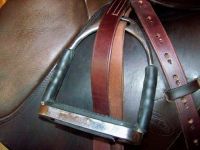 Similar in function to the English standing martingale, the western tie-down prevents a horse from raising its head above a pre-determined level. When adjusted properly, the tie-down allows a horse to carry its head freely in a natural position. It should never be so tight as to constantly snub or hold a horse’s head in place.
Similar in function to the English standing martingale, the western tie-down prevents a horse from raising its head above a pre-determined level. When adjusted properly, the tie-down allows a horse to carry its head freely in a natural position. It should never be so tight as to constantly snub or hold a horse’s head in place.
- Popular among ropers and some gymkhana competitors, tie-downs can keep a horse from hitting a rider in the face or head during intense, high-speed events.
- Tie-downs are not a substitute for schooling a horse to flex, bend and yield to the bit.
- Use care when trail riding with a tie-down strap. It may restrict a horse’s ability to use its head and neck for balance, especially when climbing up steep, narrow trails.
Back to HorseChannel’s Online Tack and Horse Equipment Guide





